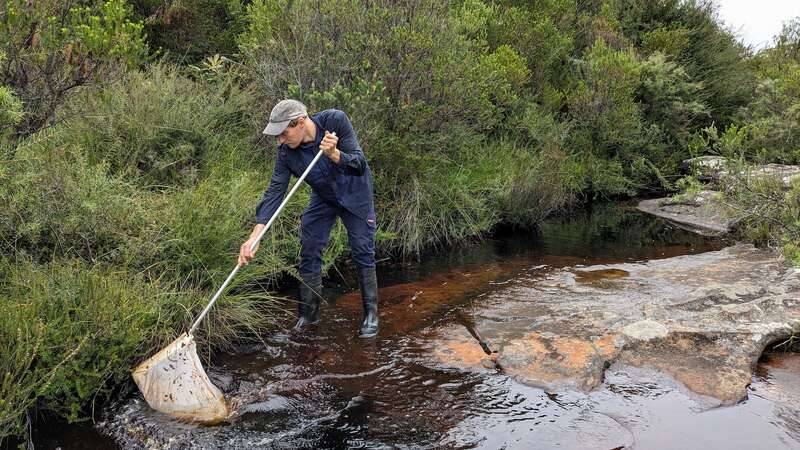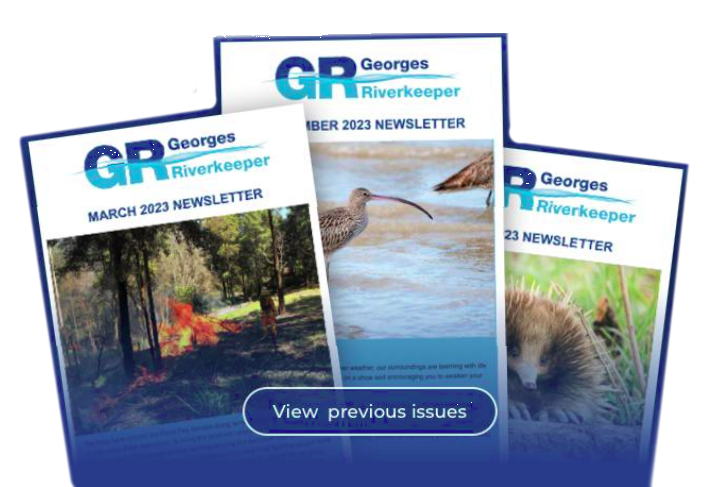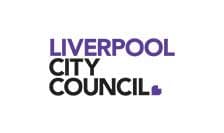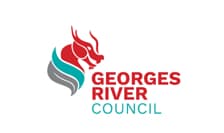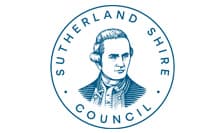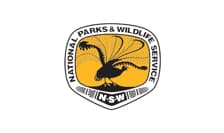The health of aquatic ecosystems in the Georges River catchment is an ongoing focus for Georges Riverkeeper. To understand what lies beneath (and above) our waterways, biennial sampling activities take our scientists through bush reserves, national parks and urban areas to reach the waterways
Carl Tippler, is an aquatic ecologist currently undertaking freshwater sampling on behalf of Georges Riverkeeper. Over the past 10 years, he has frequently undertaken biannual sampling of the waterways that make up the Georges River catchment.
In a nutshell, Carl explains, "I'm an ecologist, trying to work out the relationship between what lives in and around the waterways and the environmental variables that influence the conditions of the ecosystem."
His favourite aspect of the work he does comes from collecting samples and data, and then delving into the numbers to unravel the story they tell. "You learn to understand what's forming the condition, what animals and plants are there, and what's driving the ecosystem”.
One of the most exciting aspects for Carl is the exploration of new sites. "Having a hunch about a particular animal that might live in an area and then finding it – that's awesome," he says.
“Freshwater crayfish are always good to find,” Carl continues. “There are a few different species of crays that live in the less disturbed areas of the catchment so when these turn up it's always interesting. These crays are not to be confused with the common yabby which has a broad distribution and can tolerate harsh conditions. The crays of the upper Georges River require water that is very low in salt and acidic and a flow that is regulated by the upland swamps which act as giant sponges that slowly release flow after rainfall.”
Water Quality
The well-being of aquatic life depends on specific water quality conditions. Each plant and animal has a pollution tolerance limit, thriving only in water within that range. The Georges Riverkeeper River Health & Research Program vigilantly tracks water quality across the Georges River and its tributaries, in both the freshwater reaches and saltwater estuary within the catchment.
The water-quality indicators collected include physical and chemical parameters such as dissolved oxygen, temperature, salinity, pH, turbidity and nutrients like Phosphorus and Nitrogen. By pinpointing water quality indicators at different sites, the program reveals the impacts of pollution types and land uses in the area.
Freshwater Macroinvertebrates
Small backbone-less wonders like worms, snails, and insects inhabit freshwater ecosystems. These creatures exhibit varying sensitivities to changes in water and habitat quality. Georges Riverkeeper’s River Health & Research Program conducts surveys of aquatic macroinvertebrates in spring and autumn. Understanding which macroinvertebrates thrive or struggle in specific locations offers key information about the health of freshwater ecosystems throughout the Georges River catchment.
Riparian Vegetation
Riparian vegetation, lining waterway edges, plays a crucial role in stabilising riverbanks with intricate root systems. This living ecosystem offers habitats and food for aquatic life as leaves and branches fall into the water. Additionally, it provides shade and filters pollutants from urban stormwater runoff, safeguarding the waterway from potential harm. The contribution of riparian vegetation goes beyond mere aesthetics, actively contributing to the well-being of the Georges River catchment.
But why is this sampling so crucial?
"It's all about understanding the condition of the waterways and then being able to develop measures to improve the ecosystem, not just for animals, but for humans too,” says Carl.
“Once we develop good waterway management practices that enhance the aquatic ecosystem, we will create a ripple effect that improves conditions downstream because everything’s connected.”
Reflecting on recent observations
Early analysis of data indicates that no drastic changes have occurred this year (2024), but some natural variation due to high flooding events is evident in urban creeks. The recent constant high rainfall events have been impacting the ecology, hindering its recovery.
In terms of stormwater flows and litter, Carl explains, "High flows from storms push rubbish through, while smaller, frequent flows clean the streets but wash the rubbish into the creeks. It then gets stuck on the banks, reeds, and trees." This is something you may have seen along the waterways in your local area – and why litter prevention matters to reduce litter in the river.
The biennial freshwater sampling continues to play an important role in understanding and preserving the Georges River ecosystem. Carl Tippler and his team offer valuable scientific insights to help us keep the flora and fauna of the Georges River and its waterways in balance.

